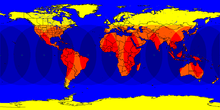O3b (satellite)
 Rendering of O3b satellite coverage areas and visibility around the Equator. | |
| Operator | O3b Networks |
|---|---|
| Spacecraft properties | |
| Dry mass | 700 kg |
| Start of mission | |
| Launch date | June 25, 2013 |
| Orbital parameters | |
| Reference system | Geocentric |
| Regime | Medium Earth |
| Eccentricity | Circular |
| Perigee | 8063 km |
| Repeat interval | 5 daily |
| Velocity | 11,755 mph |
The O3b Satellite Constellation is a satellite constellation designed for telecommunications and data backhaul from remote locations. The first four satellites were launched on 25 June 2013, and eight more in 2014.[1] There are plans to extend this to twenty satellites.[2]
The constellation is owned and operated by O3b Networks, which began offering service in March 2014.[3]
Satellites
The satellites were deployed in a circular orbit along the equator at an altitude of 8063 km (medium Earth orbit) at a velocity of approximately 11,755 mph (18,918 km/h), each making 5 orbits a day.[4] The constellation currently has twelve satellites operational in orbit, after three launches of four satellites each. Due to problems with a component of the first four satellites launched, two of those four have been placed on standby for the other two, so ten are used operationally.[5]
Each satellite is equipped with twelve fully steerable Ka band antennas (two beams for gateways, ten beams for remotes) that use 4.3 GHz of spectrum (2×216 MHz per beam) with a proposed throughput of 1.2 Gbit/s per beam (600 MBit/s per direction),[6] resulting in a total capacity of 12 GBit/s per satellite. Each beam's footprint measures 700 km in diameter.[7] O3b claims a mouth-to-ear one-way latency of 179 milliseconds for voice communication, and an end-to-end round-trip latency of 238ms for data services. The maximum throughput per TCP connection is 2.1 Mbit/s.[8] For maritime applications, O3b claims a round-trip latency of 130ms, and connectivity speeds of over 500 Mbit/s.[9]
The satellites are powered by gallium arsenide solar arrays and lithium ion batteries[10] and weigh approximately 700 kilograms (1,500 lb) each.[1]
The satellites were constructed by Thales Alenia Space, a division of Thales Group.[11] The first satellite (PFM) was built in the Cannes Mandelieu Space Center, while the rest of the constellation was assembled, integrated and tested in Thales Alenia Space Italy's Roman facilities.
References
- 1 2 ""The journey begins" with a lift from Arianespace: O3b Networks' first four satellites are in orbit". Arianespace. 25 June 2013. Retrieved 27 June 2013.
- ↑ "SES takes control of O3b, citing synergies between GEO, MEO constellations". 2016.
- ↑ Wood, Lloyd; Lou, Yuxuan; Olusola, Opeoluwa (2014). "Revisiting elliptical satellite orbits to enhance the O3b constellation". Journal of the British Interplanetary Society. 67 (3): 110–118. arXiv:1407.2521
 .
. - ↑ "iDirect's Interoperability with O3b's MEO Satellite System". 2008.
- ↑ "Two O3b Satellites Taken Out of Service as a Precaution". 2014.
- ↑ "O3b Networks Presentation" (PDF). presentation. O3b Networks. 23 February 2009. Retrieved 9 January 2013.
- ↑ "O3b website – Our technology". website. O3b Networks. Retrieved 9 January 2013.
- ↑ "Why Latency Matters to Mobile Backhaul" (PDF). O3b Networks and Sofrecom. 2013-04-18.
- ↑ "O3b Maritime" (PDF). O3b Networks. 2012-06-18.
- ↑ "O3b Networks : Space Vehicle".
- ↑ "O3b Networks : Advantage".